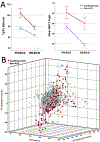Incorporation of Serial 12-Lead Electrocardiogram With Machine Learning to Augment the Out-of-Hospital Diagnosis of Non-ST Elevation Acute Coronary Syndrome
- PMID: 36253296
- PMCID: PMC9780162
- DOI: 10.1016/j.annemergmed.2022.08.005
Incorporation of Serial 12-Lead Electrocardiogram With Machine Learning to Augment the Out-of-Hospital Diagnosis of Non-ST Elevation Acute Coronary Syndrome
Abstract
Study objective: Ischemic electrocardiogram (ECG) changes are subtle and transient in patients with suspected non-ST-segment elevation (NSTE)-acute coronary syndrome. However, the out-of-hospital ECG is not routinely used during subsequent evaluation at the emergency department. Therefore, we sought to compare the diagnostic performance of out-of-hospital and ED ECG and evaluate the incremental gain of artificial intelligence-augmented ECG analysis.
Methods: This prospective observational cohort study recruited patients with out-of-hospital chest pain. We retrieved out-of-hospital-ECG obtained by paramedics in the field and the first ED ECG obtained by nurses during inhospital evaluation. Two independent and blinded reviewers interpreted ECG dyads in mixed order per practice recommendations. Using 179 morphological ECG features, we trained, cross-validated, and tested a random forest classifier to augment non ST-elevation acute coronary syndrome (NSTE-ACS) diagnosis.
Results: Our sample included 2,122 patients (age 59 [16]; 53% women; 44% Black, 13.5% confirmed acute coronary syndrome). The rate of diagnostic ST elevation and ST depression were 5.9% and 16.2% on out-of-hospital-ECG and 6.1% and 12.4% on ED ECG, with ∼40% of changes seen on out-of-hospital-ECG persisting and ∼60% resolving. Using expert interpretation of out-of-hospital-ECG alone gave poor baseline performance with area under the receiver operating characteristic (AUC), sensitivity, and negative predictive values of 0.69, 0.50, and 0.92. Using expert interpretation of serial ECG changes enhanced this performance (AUC 0.80, sensitivity 0.61, and specificity 0.93). Interestingly, augmenting the out-of-hospital-ECG alone with artificial intelligence algorithms boosted its performance (AUC 0.83, sensitivity 0.75, and specificity 0.95), yielding a net reclassification improvement of 29.5% against expert ECG interpretation.
Conclusion: In this study, 60% of diagnostic ST changes resolved prior to hospital arrival, making the ED ECG suboptimal for the inhospital evaluation of NSTE-ACS. Using serial ECG changes or incorporating artificial intelligence-augmented analyses would allow correctly reclassifying one in 4 patients with suspected NSTE-ACS.
Trial registration: ClinicalTrials.gov NCT04237688.
Copyright © 2022 American College of Emergency Physicians. Published by Elsevier Inc. All rights reserved.
Figures




Similar articles
-
Towards prehospital risk stratification using deep learning for ECG interpretation in suspected acute coronary syndrome.BMJ Health Care Inform. 2025 Jun 6;32(1):e101292. doi: 10.1136/bmjhci-2024-101292. BMJ Health Care Inform. 2025. PMID: 40480678 Free PMC article.
-
In Search of an Optimal Subset of ECG Features to Augment the Diagnosis of Acute Coronary Syndrome at the Emergency Department.J Am Heart Assoc. 2021 Feb 2;10(3):e017871. doi: 10.1161/JAHA.120.017871. Epub 2021 Jan 17. J Am Heart Assoc. 2021. PMID: 33459029 Free PMC article.
-
Cardiogoniometry as a diagnostic tool in patients with acute coronary syndromes: results of the CGM@ACS trial.Clin Res Cardiol. 2012 Sep;101(9):727-36. doi: 10.1007/s00392-012-0452-2. Epub 2012 Apr 7. Clin Res Cardiol. 2012. PMID: 22485015 Free PMC article.
-
Machine learning for the diagnosis of acute coronary syndrome using a 12-lead ECG: a systematic review.CJEM. 2023 Oct;25(10):818-827. doi: 10.1007/s43678-023-00572-5. Epub 2023 Sep 4. CJEM. 2023. PMID: 37665551
-
Prehospital risk assessment in patients suspected of non-ST-segment elevation acute coronary syndrome: a systematic review and meta-analysis.BMJ Open. 2022 Apr 5;12(4):e057305. doi: 10.1136/bmjopen-2021-057305. BMJ Open. 2022. PMID: 35383078 Free PMC article.
Cited by
-
Prospective Human Validation of Artificial Intelligence Interventions in Cardiology: A Scoping Review.JACC Adv. 2024 Aug 28;3(9):101202. doi: 10.1016/j.jacadv.2024.101202. eCollection 2024 Sep. JACC Adv. 2024. PMID: 39372457 Free PMC article.
-
Artificial Intelligence in Clinics: Enhancing Cardiology Practice.JMA J. 2025 Jan 15;8(1):131-140. doi: 10.31662/jmaj.2024-0190. Epub 2024 Dec 24. JMA J. 2025. PMID: 39926098 Free PMC article. Review.
-
Personalized ECG monitoring and adaptive machine learning.J Electrocardiol. 2024 Jan-Feb;82:131-135. doi: 10.1016/j.jelectrocard.2023.12.006. Epub 2023 Dec 13. J Electrocardiol. 2024. PMID: 38128158 Free PMC article. Review.
-
Machine learning for ECG diagnosis and risk stratification of occlusion myocardial infarction.Nat Med. 2023 Jul;29(7):1804-1813. doi: 10.1038/s41591-023-02396-3. Epub 2023 Jun 29. Nat Med. 2023. PMID: 37386246 Free PMC article.
-
Machine Learning for the ECG Diagnosis and Risk Stratification of Occlusion Myocardial Infarction at First Medical Contact.Res Sq [Preprint]. 2023 Jan 30:rs.3.rs-2510930. doi: 10.21203/rs.3.rs-2510930/v1. Res Sq. 2023. Update in: Nat Med. 2023 Jul;29(7):1804-1813. doi: 10.1038/s41591-023-02396-3. PMID: 36778371 Free PMC article. Updated. Preprint.
References
-
- Niska R, Bhuiya F, Xu J. National Hospital Ambulatory Medical Care Survey: 2007 emergency department summary. Natl Health Stat Report. 2010(26):1–31. - PubMed
-
- Gulati M, Levy PD, Mukherjee D, et al. 2021 AHA/ACC/ASE/CHEST/SAEM/SCCT/SCMR Guideline for the Evaluation and Diagnosis of Chest Pain: A Report of the American College of Cardiology/American Heart Association Joint Committee on Clinical Practice Guidelines. Circulation. 2021;144(22):e368–e454. - PubMed
-
- O’Gara PT, Kushner FG, Ascheim DD, et al. 2013 ACCF/AHA guideline for the management of ST-elevation myocardial infarction: a report of the American College of Cardiology Foundation/American Heart Association Task Force on Practice Guidelines. Circulation. 2013;127(4):e362–425. - PubMed
-
- Ibanez B, James S, Agewall S, et al. 2017 ESC Guidelines for the management of acute myocardial infarction in patients presenting with ST-segment elevation: The Task Force for the management of acute myocardial infarction in patients presenting with ST-segment elevation of the European Society of Cardiology (ESC). Eur Heart J. 2018;39(2):119–177. - PubMed
-
- Bradley EH, Herrin J, Wang Y, et al. Strategies for reducing the door-to-balloon time in acute myocardial infarction. N Engl J Med. 2006;355(22):2308–2320. - PubMed
Publication types
MeSH terms
Associated data
Grants and funding
LinkOut - more resources
Full Text Sources
Medical

